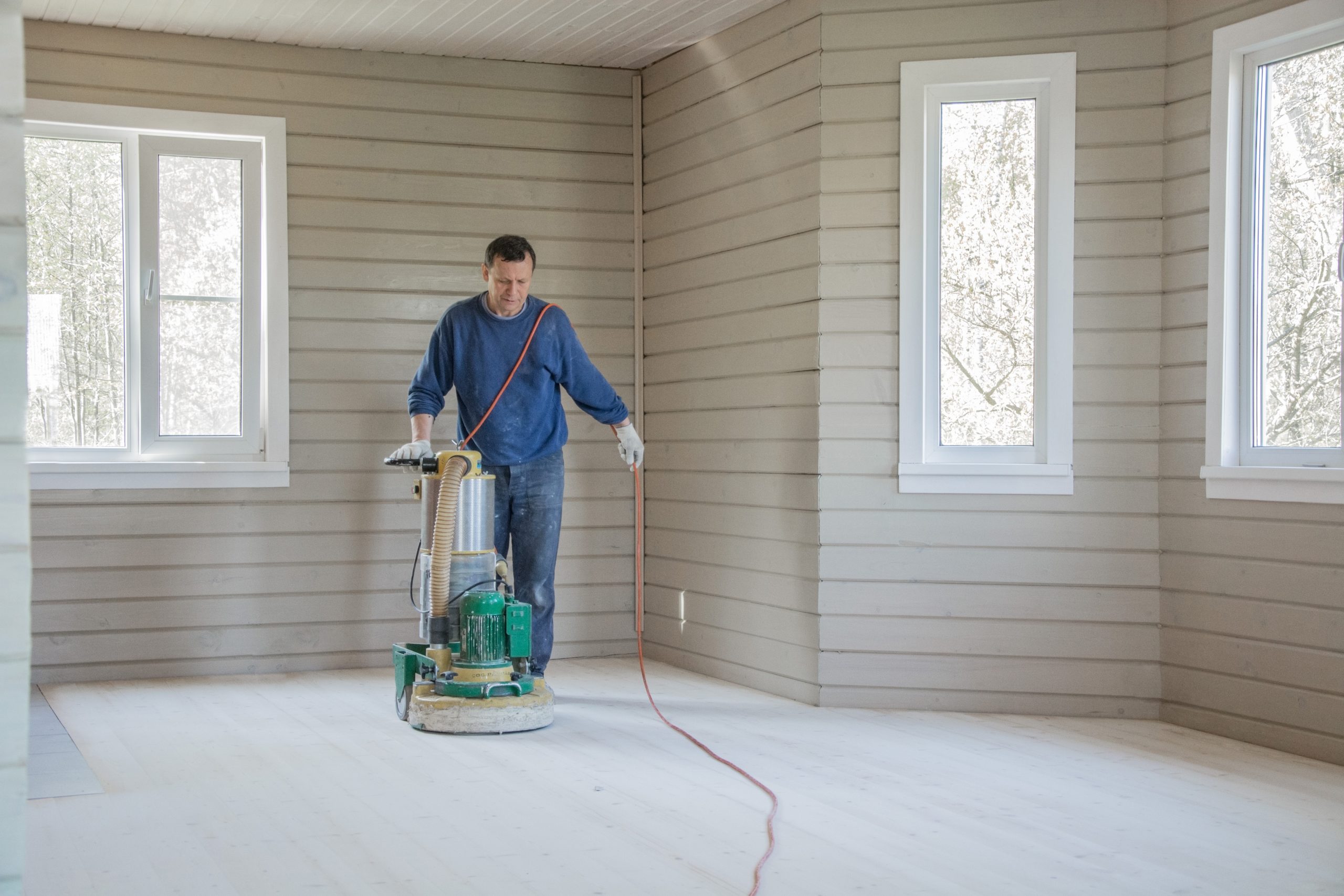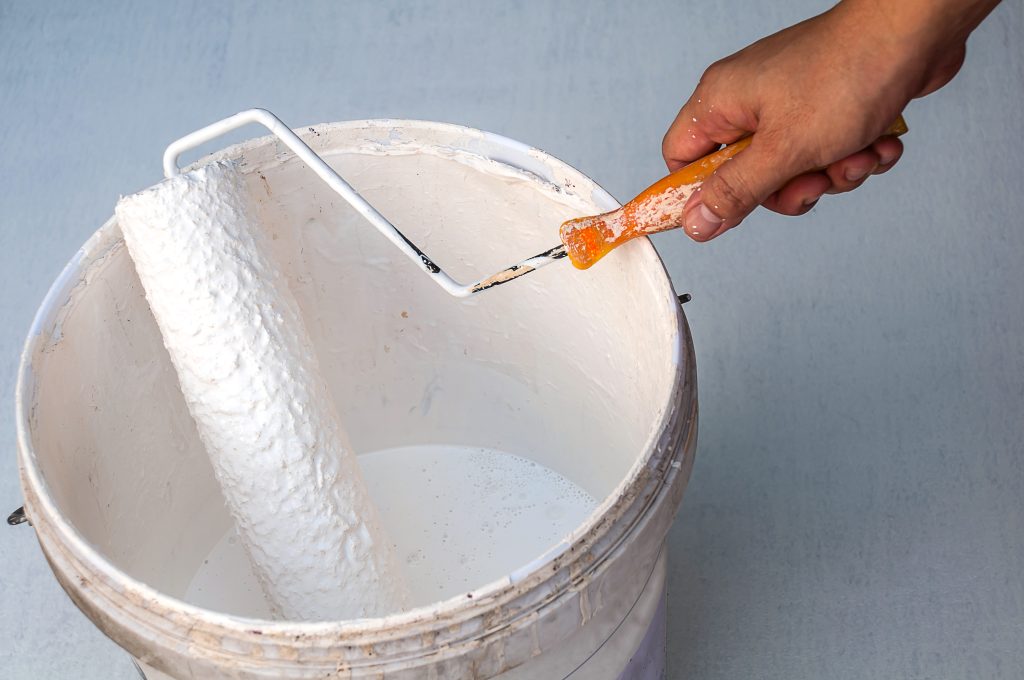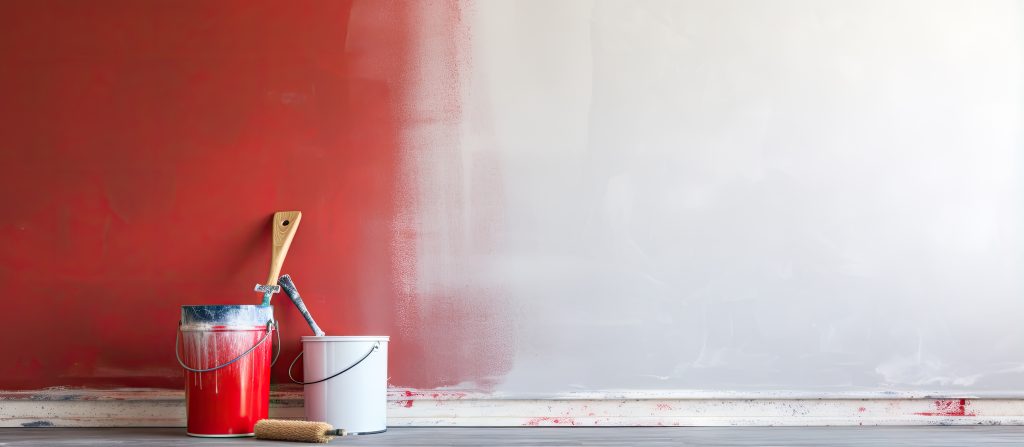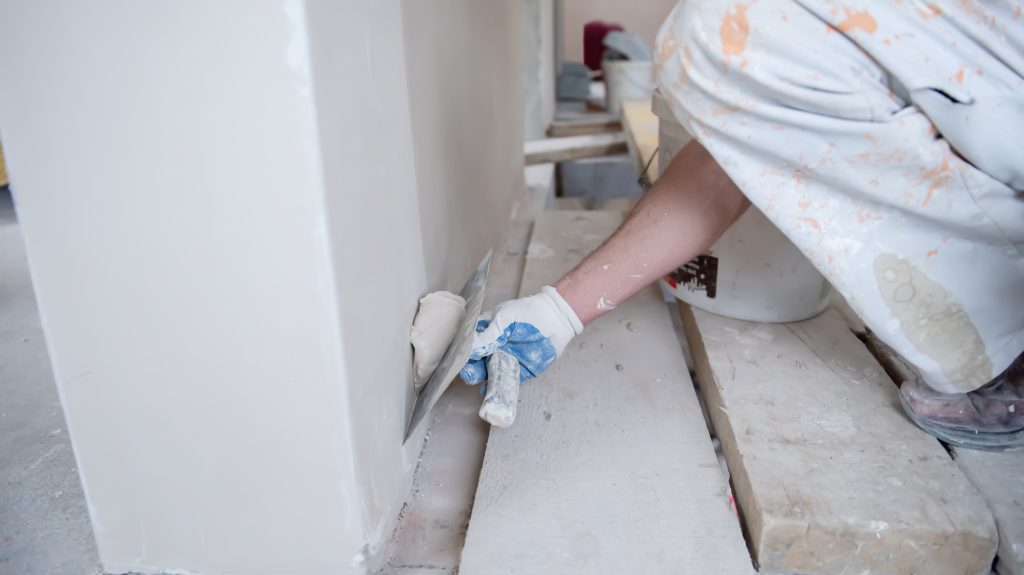
Did you know that nearly 75% of paint failures are due to not preparing surfaces well? This shows how vital good preparation is for a great paint job. When we start painting, knowing how to prepare surfaces is key.

Clean, well-prepared surfaces help paint stick better. This reduces peeling, bubbling, or cracking. By doing this important step, we ensure our paint job looks great and lasts long.
Why Surface Preparation is Crucial for Paint Adhesion
To get perfect paint adhesion, good surface prep is key. It makes sure the paint sticks well and lasts longer. This keeps the painted area looking good for longer.

The Role of Clean Surfaces
Having a clean surface is vital in preparing for painting. Dirt, oil, or dust can stop paint from sticking properly. Cleaners like Zinsser detergent can get rid of these issues. This helps the paint stick better and stronger.
Impact of Imperfections and Contaminants
Surface flaws and dirt greatly affect the paint’s quality and life. Tiny blemishes or scratches can mess up the paint’s even spread. Rust or old paint can cause the new paint to peel or bubble up. Fixing these issues before painting helps achieve a smooth, long-lasting finish.
Understanding Surface Contaminants and Their Removal
When getting a surface ready for painting, it’s crucial to deal with common contaminants. These can greatly affect how well the paint sticks and looks. Issues like dust, grease, and rust are common problems. They need special cleaning methods to make sure the paint job turns out great.

Common Contaminants: Dust, Grease, and Rust
Dust, grease, and rust often ruin the quality of surfaces. Dust can stick in wet paint, leaving a rough texture. Grease, usually found in kitchens, stops paint from sticking well.
Rust affects metal and makes it hard for paint to stick. It can also eat away at the metal if not treated right.
Effective Cleaning Methods
Here’s how to clean these problems away:
- Dust Removal: Clean up dust with microfiber cloths or vacuums with brush attachments.
- Grease Removal: Use special cleaners or degreasers to get rid of grease. Wash them off with water afterwards.
- Rust Removal: Get rid of rust with wire brushes, sanding sponges, or sandpaper. Then, use a primer that stops rust to keep it from coming back.
By using these cleaning steps, you can make sure the surface is clean and ready for paint. This helps make the paint last longer and look better.
The Importance of Proper Surface Preparation Before Painting
Getting the surface ready is key before painting. It helps the paint stick well, making the paint job last longer. Our goal with proper surface preparation is to clean and prime the surface. This gets rid of dirt, grease, and rust.
By preparing the surface well, we improve the paint’s performance. It will be able to last through time and weather. Starting to apply paint with care in preparation shows in the end result. A ready surface means a smooth, nice finish that stays beautiful for a long time.

The life of the paint or coating relies not just on its quality. It also depends greatly on how well we prepare the surface. Skipping or hurrying this step can cause bad sticking, peeling, and flaking. This ruins the whole paint job.
To sum up, proper surface preparation is critical for a good paint job. It’s a step we should never miss. It ensures the paint works its best, leaving a beautiful and tough finish.
Common Techniques for Surface Preparation
There are many methods to prepare surfaces for painting. Good preparation is key for paint to stick well and last. Let’s look at the most popular ways to get surfaces ready for paint.
Hand and Power Tool Cleaning
Hand tool cleaning is a basic method. It uses tools like wire brushes and sandpapers. This removes loose paint and rust by hand. It works great for small areas or spots that are hard to reach.

Power tool cleaning is for bigger areas. Power sanders and grinders take off tough coatings fast. They save a lot of time and work compared to hand tools.
Abrasive Blasting
Abrasive blasting is a strong way to clean. It shoots particles at the surface to clean it. This method gets rid of hard-to-remove stuff like old paint and rust. It’s adjusted based on the surface and how clean it needs to be.
This technique is often used for big jobs. It cleans surfaces well, making them perfect for painting.
Solvent Cleaning
Solvent cleaning gets rid of oils and grease. Solvents dissolve these contaminants. This is important where machines or equipment might leak these substances.
Using these surface preparation techniques ensures surfaces are ready for paint. Whether it’s hand tools, power tools, abrasive blasting, or solvent cleaning, good preparation is the first step to a great paint job.
How to Prepare Different Types of Surfaces
To get a perfect paint job, we need to prep surfaces in certain ways. Knowing how to prep helps us get a smooth finish.
For steel surfaces, cleaning off grease, oil, or rust is key. Use degreasing agents and abrasive blasting for the best clean. This makes a smooth base for the paint to stick to.
Working with wooden surfaces is a bit different. Sanding them makes them smooth and ready for primer. The primer seals the wood, ensuring the paint goes on evenly. This stops peeling or patchy paint.
Using these specific prep techniques, whether for steel surface or wooden surfaces, leads to a pro and lasting paint job. Each material needs its own approach for the best finish.
The Significance of Using Primers
Before you start painting, it’s key to prepare the area right. This means applying primer first. Primers help create the perfect surface for the paint to stick to. They ensure the finish looks smooth and lasts a long time.
Enhancing Paint Adhesion
Primers are super important for making paint stick better. When we prime before painting, it adds a layer for the paint to hold onto. This step is key for porous surfaces or areas with old paint. Applying primer helps the new paint stay on strong, so it doesn’t peel or chip easily.
Providing a Uniform Base
Primers also make the surface even so paint goes on smoothly. This matters a lot when covering old colors or fixing blemishes. A primer coat hides these issues and gives a consistent finish.
Ultimately, using primer is crucial, no matter the material you’re painting. It helps achieve a professional-looking paint job that will look great for years.
Dealing with Rust and Metal Surfaces
Keeping metal surfaces in good shape means dealing with rust correctly. Rust makes metal look bad and weakens it over time. We can beat rust by using different rust removal methods and protection strategies.
Rust Removal Techniques
To start, removing rust is key. Tools like wire brushes and sandpaper help get to a solid, rust-free surface. For tough rust, we might need to use abrasive blasting.
Using Rust-Inhibiting Primers
Once we remove the rust, it’s important to apply rust-inhibiting primers. These primers stop rust from coming back and help paint stick better. This makes our paint job last longer and keeps metal surfaces safe.
Special Considerations for Glossy Surfaces
When painting glossy surfaces, we must be careful to make sure the paint sticks well. Glossy surfaces are slick, making it hard for paint to cling properly. The first thing to do is prepare the surface well.
To get ready for painting glossy finishes, start by making the surface less shiny. You can do this by lightly sanding it. This makes it easier for new paint to hold on. Make sure to sand the whole area so it’s all equally rough.
Then, it’s important to put on a bonding primer. This special primer sticks to glossy surfaces. It makes a solid base for the paint. A top-notch bonding primer improves how well the paint sticks and lasts longer.
In short, the secret to painting glossy surfaces well is good preparation. Sanding to remove shine and using a bonding primer sets the stage. Then, the paint can stick well and give a lasting, beautiful look.
Procedures for Addressing Old Paint
When removing old paint, we must be very careful. The first thing to do is scrape off loose or peeling paint. This step is essential for preventing future problems with the new paint.
After removing most of the old paint, we move to sanding. Sanding makes the surface smoother, helping the new paint stick better. Before moving forward, the surface should be completely free of dust.
Cleanliness is key to a good painting job. We have to make sure the surface has no dust, dirt, or grease. A clean surface ensures the new paint looks great.
Following these steps prepares the surface well for new paint. It helps create a durable and beautiful finish.
Types of Surface Profiles
Knowing the different surface profiles is key to great painting results. Surface profiling is crucial for the paint’s stickiness and its lasting power. Let’s look at the blast cleaning levels and their role in preparing surfaces.
Light Blast Cleaning
Light blast cleaning is for when only a bit of cleaning is needed. It’s perfect for getting rid of light rust, mill scale, and old paint. The surfaces get a light abrasive blast, making a good foundation for simple coatings.
Industrial Blast Cleaning
Industrial blast cleaning goes deeper, for surfaces needing a good clean, like slightly rusty metals. It gets rid of mill scale, rust, and old paint for a smoother surface. This means paint sticks better and lasts longer.
White Metal Blast Cleaning
White metal blast cleaning is the strongest option, clearing away all dirt. It’s best for areas needing heavy-duty coatings, giving a clean, even surface. With the highest cleaning level, it guarantees strong paint adherence and the best durability.
The Consequences of Skipping Surface Preparation
Not preparing surfaces can cause many problems, hurting both the look and life of a paint job. It’s vital to know how important surface prep is. Skipping this key step almost always leads to paint not lasting.
Bad prep might cause paint to peel, crack, or bubble. These issues ruin the look and make the paint less durable. Fixing these problems due to poor prep can be expensive.
It’s crucial to clean and prep the surface well to avoid these problems. This makes sure the paint sticks well, looking good and lasting long. Understanding and doing good surface prep helps prevent paint trouble, leading to a smooth and lasting finish.
Success Stories: Benefits of Proper Preparation
Let’s talk about the benefits of proper surface preparation. It makes a big difference in success stories. For example, homeowners who focus on good prep work get long-lasting, perfect finishes.
Think about a commercial project where getting surfaces ready was key. This led to the paint lasting longer and much lower costs for upkeep. It proves how preparing surfaces correctly is critical for great results.
The benefits of proper surface preparation shine in all kinds of projects. Whether it’s a large industrial job or a small home task, good prep makes paint stick better. This results in a look that lasts and makes clients happy. These successful painting projects show the worth of prepping right.
Conclusion
Preparing the surface before painting is very important. This article has shown us that good prep is the foundation of a good paint job. We’ve learned about cleaning off dirt, using the right primers, and dealing with rust. Every step is important for a long-lasting and good-looking finish.
Good preparation makes sure our painting work lasts. Clean surfaces, proper prep methods, and the right primers make a big difference. If we skip these steps, we might see peeling, cracking, and other problems. These issues can ruin our project.
As we finish, remember that a well-prepped surface is key for long-lasting paint. Taking the time to prep properly is worth it. It makes sure our paint jobs last and look as we want them to. So, let’s give every paint job the attention and effort it needs. This shows how valuable good preparation is.
FAQ
What is the importance of proper surface preparation before painting?
Making sure the surface is ready before painting is key. It helps the paint stick better, avoiding peeling or cracking. Steps like cleaning and sanding create a strong, good-looking finish.
Why is surface preparation crucial for paint adhesion?
Preparing the surface is essential for the paint to stick properly. Things like dust and grease can stop paint from sticking. A clean, smooth surface means the paint will bond well.
How do imperfections and contaminants affect paint adhesion?
Surface flaws and dirt can mess with the paint’s grip, causing peeling. The right prep fixes these issues for a lasting paint job.
What are common surface contaminants, and how do we remove them?
Dust, grease, and rust are usual troublemakers. To clean them off, use special detergents, power washing, and tools like sandpaper.
What are effective cleaning methods for preparing surfaces?
To clean surfaces well, use detergents for grease and power wash exteriors. Sandpaper or wire brushes also help get surfaces ready.
What are common techniques for surface preparation?
Usual methods include cleaning by hand or with tools, abrasive blasting, and using solvents. These prepare the surface for the paint to stick properly.
How do we prepare different types of surfaces for painting?
Different surfaces need different prep. Metal needs degreasing and rust treatment. Wood needs sanding and priming for a smooth start.
What is the significance of using primers in surface preparation?
Primers help paint stick better and make a uniform base. They cover old colours to ensure they don’t peek through the new paint.
How can we effectively deal with rust on metal surfaces?
To handle rust, use wire brushes and sandpaper to get to the solid surface. Then apply a rust-preventing primer for a lasting effect.
What special considerations are there for glossy surfaces?
For glossy surfaces, dull the shine with light sanding. Then, use a bonding primer for a surface that paint sticks to well.
What are the procedures for addressing old paint before repainting?
To deal with old paint, remove any that’s loose or peeling. Sand for smoothness, and ensure it’s clean before repainting or priming.
What are the types of surface profiles achieved through blast cleaning?
Blast cleaning can make surfaces lightly, industrially, or very clean for new paint. This ensures coatings stick well and last long.
What are the consequences of skipping surface preparation?
Skipping prep can cause paint to peel, crack, or bubble. Proper care avoids these problems, making the paint look good and last.
What are some success stories related to proper surface preparation?
Success stories include homeowners with perfect finishes from careful prep. Also, commercial projects saw longer-lasting results and lower upkeep costs.

